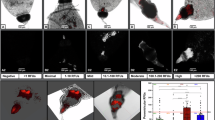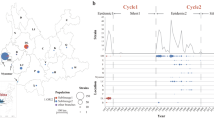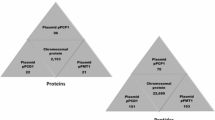Abstract
Plague, caused by the bacterium Yersinia pestis, is a mammalian vector-borne disease, transmitted by fleas that serve as the vector between rodent hosts. For many pathogens, including Y. pestis, there are strong evolutionary pressures that lead to a reduction in ‘useless genes’, with only those retained that reflect function in the specific environment inhabited by the pathogen. Genetic traits critical for survival and transmission between two environments, the rodent and the flea, are conserved in epizootic/epidemic plague strains. However, there are genes that remain conserved for which no function in the flea–rodent cycle has yet been observed, indicating an additional environment may exist in the transmission cycle of plague. Here, we present evidence for highly conserved genes that suggests a role in the persistence of Y. pestis after death of its host. Furthermore, maintenance of these genes points to Y. pestis traversing a post-mortem path between, and possibly within, epizootic periods and offering insight into mechanisms that may allow Y. pestis an alternative route of transmission in the natural environment.
Similar content being viewed by others
Log in or create a free account to read this content
Gain free access to this article, as well as selected content from this journal and more on nature.com
or
References
Achtman M, Morelli G, Zhu P, Wirth T, Diehl I, Kusecek B et al. (2004). Microevolution and history of the plague bacillus, Yersinia pestis. Proc Natl Acad Sci USA 101: 17837–17842.
Achtman M, Zurth K, Morelli G, Torrea G, Guiyoule A, Carniel E . (1999). Yersinia pestis, the cause of plague, is a recently emerged clone of Yersinia pseudotuberculosis. Proc Natl Acad Sci USA 96: 14043–14048.
Agar SL, Sha J, Baze WB, Erova TE, Foltz SM, Suarez G et al. (2009). Deletion of Braun lipoprotein gene (lpp) and curing of plasmid pPCP1 dramatically alter the virulence of Yersinia pestis CO92 in a mouse model of pneumonic plague. Microbiology 155: 3247–3259.
Anisimov AP . (2002). Factors of Yersinia pestis providing circulation and persistence of plague pathogen in ecosystems of natural foci. Communication 2. Molekulyarnaya Genetika Mikrobiologiya i Virusologiya 5: 1–14.
Anisimov AP, Lindler LE, Pier GB . (2004). Intraspecific diversity of Yersinia pestis. Clin Microbiol Rev 17: 434–464.
Ayyadurai S, Houhamdi L, Lepidi H, Nappez C, Raoult D, Drancourt M . (2008). Long-term persistence of virulent Yersinia pestis in soil. Microbiology 154: 2865–2871.
Bearden SW, Brubaker RR . (2010). Recent findings regarding maintenance of enzootic variants of Yersinia pestis in Sylvatic reservoirs and their significance in the evolution of epidemic plague. Vector-Borne Zoonotic Dis 10: 85–92.
Chao L, Levin BR . (1981). Structured habitats and the evolution of anticompetitor toxins in bacteria. Proc Natl Acad Sci USA 78: 6324–6328.
Cohn SK . (2008). Epidemiology of the black death and successive waves of plague. Med Hist Suppl 27: 74–100.
Davis S, Begon M, De Bruyn L, Ageyev VS, Klassovskiy NL, Pole SB et al. (2004). Predictive thresholds for plague in Kazakhstan. Science 304: 736–738.
Drancourt M, Houhamdi L, Raoult D . (2006). Yersinia pestis as a telluric, human ectoparasite-borne organism. Lancet Infect Dis 6: 234–241.
Ebert D . (1998). Experimental evolution of parasites. Science 282: 1432–1436.
Eisen RJ, Bearden SW, Wilder AP, Montenieri JA, Antolin MF, Gage KL . (2006). Early-phase transmission of Yersinia pestis by unblocked fleas as a mechanism explaining rapidly spreading plague epizootics. Proc Natl Acad Sci USA 103: 15380–15385.
Eisen RJ, Gage KL . (2009). Adaptive strategies of Yersinia pestis to persist during inter-epizootic and epizootic periods. EDP Sci 40: 01.
Eisen RJ, Petersen JM, L HC, Wong D, Levy CE, Mead PS et al. (2008). Persistence of Yersinia pestis in soil under natural conditions. Emerg Infect Dis 14: 941–943.
Engelthaler D, Hinnebusch B, Rittner C, Gage K . (2000). Quantitative competitive PCR as a technique for exploring flea-Yersina pestis dynamics. Am J Trop Med Hyg 62: 552–560.
Feodorova VA, Devdariani ZL . (2001). Expression of acid-stable proteins and modified lipopolysaccharide of Yersinia pestis in acidic growth medium. J Med Microbiol 50: 979–985.
Ferber DM, Brubaker RR . (1979). Mode of action of pesticin: N-acetylglucosaminidase activity. J Bacteriol 139: 495–501.
Frost LS, Leplae R, Summers AO, Toussaint A . (2005). Mobile genetic elements: the agents of open source evolution. Nat Rev Micro 3: 722–732.
Gage KL, Kosoy MY . (2005). The natural history of plague: perspectives from more than a century of research. Ann Rev Entomol 50: 505–528.
Gill-King H . (1997). Forensic Taphonomy: The Postmortem Fate of Human Remains. CRC Press: Boca Raton, FL, USA, pp 94–95.
Guarner J, Shieh W-J, Chu M, Perlman DC, Kool J, Gage KL et al. (2005). Persistent Yersinia pestis antigens in ischemic tissues of a patient with septicemic plague. Human Pathol 36: 850–853.
Haensch S, Bianucci R, Signoli M, Rajerison M, Schultz M, Kacki S et al. (2010). Distinct clones of Yersinia pestis caused the black death. PLoS Pathog 6: e1001134.
Haiko J, Kukkonen M, Ravantti JJ, Westerlund-Wikstrom B, Korhonen TK . (2009). The single substitution I259T, conserved in the plasminogen activator Pla of pandemic Yersinia pestis branches, enhances Fibrinolytic activity. J Bacteriol 191: 4758–4766.
Handel A, Bennett MR . (2008). Surviving the bottleneck: transmission mutants and the evolution of microbial populations. Genetics 180: 2193–2200.
Hinnebusch BJ, Fischer Elizabeth R, Schwan Tom G . (1998). Evaluation of the role of the Yersinia pestis Plasminogen activator and other plasmid encoded factors in temperature dependent blockage of the Flea. J Infect Dis 178: 1406–1415.
Hinnebusch BJ, Rudolph AE, Cherepanov P, Dixon JE, Schwan TG, Forsberg A . (2002). Role of Yersinia murine toxin in survival of Yersinia pestis in the midgut of the flea vector. Science 296: 733–735.
Karimi Y . (1963). Natural preservation of plague in soil (French). Bull Soc Pathol Exot Filiales 56: 1183–1186.
Levin BR, Bull JJ . (1994). Short-sighted evolution and the virulence of pathogenic microorganisms. Trends Microbiol 2: 76–81.
Moran NA . (2002). Microbial minimalism: genome reduction in bacterial pathogens. Cell 108: 583–586.
Morelli G, Song Y, Mazzoni CJ, Eppinger M, Roumagnac P, Wagner DM et al. (2010). Yersinia pestis genome sequencing identifies patterns of global phylogenetic diversity. Nat Genet 42: 1140–1143.
Motin VL, Georgescu AM, Fitch JP, Gu PP, Nelson DO, Mabery SL et al. (2004). Temporal global changes in gene expression during temperature transition in Yersinia pestis. J Bacteriol 186: 6298–6305.
Parkinson RA, Dias K-R, Horswell J, Greenwood P, Banning N, Tibbett M et al. (2009). Microbial community analysis of human decomposition on soil. Criminal Environ Soil Forensics 24: 379–394.
Pawlowski DR, Metzger DJ, Raslawsky A, Howlett A, Siebert G, Karalus RJ et al. (2011). Entry of Yersinia pestis into the viable but nonculturable state in a low-temperature tap water microcosm. PLoS One 6: e17585.
Rakin A, Boolgakowa E, Heesemann J . (1996). Structural and functional organization of the Yersinia pestis bacteriocin pesticin gene cluster. Microbiology 142: 3415–3424.
Sebbane F, Jarrett CO, Gardner D, Long D, Hinnebusch BJ . (2006). Role of the Yersinia pestis plasminogen activator in the incidence of distinct septicemic and bubonic forms of flea-borne plague. Proc Natl Acad Sci USA 103: 5526–5530.
Stenseth NC, Samia NI, Viljugrein H, Kausrud KL, Begon M, Davis S et al. (2006). Plague dynamics are driven by climate variation. Proc Natl Acad Sci USA 103: 13110–13115.
Stenseth NC, Atshabar BB, Begon M, Belmain SR, Bertherat E, Carniel E et al. (2008). Plague: past, present, and future. PLoS Med 5: 9–13.
Straley SC, Perry RD . (1995). Environmental modulation of gene expression and pathogenesis in Yersinia. Trends Microbiol 3: 310–317.
Suchkov IuG, Khudiakov IV, Emel'ianenko EN, Levi MI, Pushkareva VI, Suchko IIu et al. (1997). The possibility of preserving the causative agent of plague in resting (nonculturable) form. Zh Mikroiol Epidemiol Immunobiol 4: 42–46.
Vollmer W, Pilsl H, Hantke K, Holtje J, Braun V . (1997). Pesticin displays muramidase activity. J Bacteriol 179: 1580–1583.
Wimsatt J, Biggins DE . (2009). A review of plague persistence with special emphasis on fleas. Natl Inst Malaria Res 46: 85–99.
Wren BW . (2003). The Yersiniae a model genus to study the rapid evolution of bacterial pathogens. Nat Rev Micro 1: 55–64.
Zhou D, Yang R . (2009). Molecular darwinian evolution of virulence in Yersinia pestis. Infect Immun 77: 2242–2250.
Acknowledgements
We would like to thank Eric De Muinck and Thomas Haverkamp for lending their knowledge during the inception of this paper. We also thank Anna Mazzarella for making Photoshop and its various layers accessible. Part of this work was funded through the US Department of Homeland Security.
Author information
Authors and Affiliations
Corresponding author
Rights and permissions
About this article
Cite this article
Easterday, W., Kausrud, K., Star, B. et al. An additional step in the transmission of Yersinia pestis?. ISME J 6, 231–236 (2012). https://doi.org/10.1038/ismej.2011.105
Received:
Revised:
Accepted:
Published:
Issue date:
DOI: https://doi.org/10.1038/ismej.2011.105
Keywords
This article is cited by
-
Exploring and Mitigating Plague for One Health Purposes
Current Tropical Medicine Reports (2022)
-
Vector-Borne Pathogens in Ectoparasites Collected from High-Elevation Pika Populations
EcoHealth (2020)
-
Evaluation of Yersinia pestis Transmission Pathways for Sylvatic Plague in Prairie Dog Populations in the Western U.S.
EcoHealth (2016)
-
Persistence of plague outbreaks among great gerbils in Kazakhstan: effects of host population dynamics
Population Ecology (2015)



